|
Ritchie Blackmore A look on Ritchie's gear 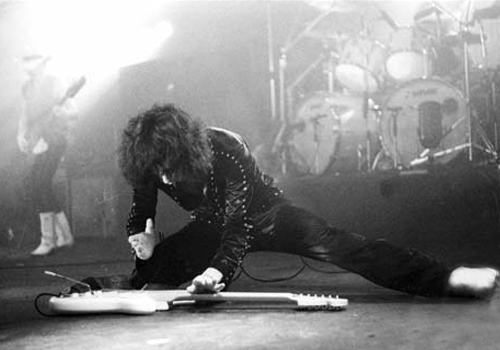 At the end of 1968, DP_Mk1 was the opening act on the "Cream" tour, at this time Deep Purple was well known in the USA, but not in their home country England. It was the last tour for "Cream", before the band felt apart. It was a sad situation for Eric Clapton, after Ritchie opened the concerts with his agressive guitar show, the guitar orientated audience wanted to hear more Blackmore. So after only a few shows, Deep Purple was payed out to leave the tour. During this days, a retired Stratocaster from Eric Clapton was given to Ritchie, and he soon felt in love with this model. Especially the tremolo caught his eye, compared to the Bigsby on his Gibson ES-335, this was a real enhancement. Ritchie had no complains about his ES-335, even Dave Edmunds, the whizz kid of the new and upcoming hardrock scene (Love Sculpture) used an ES-335 with a Vox AC30 amp to show them all what guitar playing really means when recording his ultra speedy version of the "Sabre Dance". 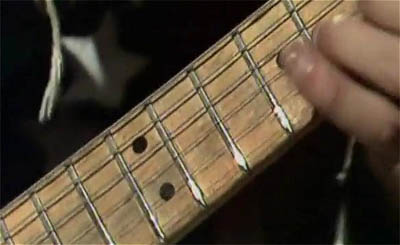 The combination on an ES-335 and a Vox AC30 was the top of the line setup at this time! But since Hendrix everybody was aware, what could be done with a Strat. Ritchie bought a stock 1968 black maple neck Stratocaster in spring 1969. The 68 Strats still had the 0.1uF tone cap, so you could dial in a more bassy tone on this pre-71'Strats as on the later Strats with the 0.047uF tone cap.
The combination on an ES-335 and a Vox AC30 was the top of the line setup at this time! But since Hendrix everybody was aware, what could be done with a Strat. Ritchie bought a stock 1968 black maple neck Stratocaster in spring 1969. The 68 Strats still had the 0.1uF tone cap, so you could dial in a more bassy tone on this pre-71'Strats as on the later Strats with the 0.047uF tone cap. Besides this, the 68 Strats still had the two-piece old tremolo construction with the steel inertia bar and the stamped vintage steel saddles. For this tremolo, Ritchie used a special custom made 1/4" (6.3mm) heavy weigthed steel arm, to attack the tremolo real hard. At the end of 1970 / early 1971 the worn-out frets of this Strat were replaced with Gibson jumbo frets. The maple fretboard was not newly lacquered afterwards, so it became noticeably darker with time. This was the guitar, Ritchie used to record "Fireball" at spring 1971. This black 68'Strat was Ritchie's main axe until summer 1972. As for amps, Ritchie used the 200 watt Marshall Major models right from the start with Deep Purple. Until summer 1973 Ritchie played his Strat live only into a treblebooster and from there directly into his amps. In the studio, Ritchie used this booster until 1975. He also used the Dallas-Arbiter FuzzFace in his early days, sometimes even with a treblebooster in front of it to push it harder. This sound can be heard on the legendary "Deep Purple in Rock" recordings. With this configuration (pushing the old two-transistor FuzzFace with a treblebooster), Ritchie created a very similar circuit with identical sound character as the end 60's common 2nd generation Fuzz boxes like the Solasound Professional Mk2 or the Marshall Supa Fuzz that Eric Clapton really liked. 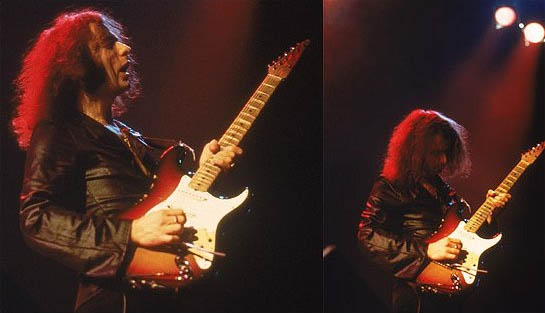 At the beginning of 1971 a new 70's sunburst Strat showed up, sporting a four-bolt maple neck with skunk stripe, two-piece steel tremolo, stock pickups and electrics and like on his old black Strat, a heavy custom-made tremolo arm out of steel, but not as heavy and thick as on the 68 Strat.
At the beginning of 1971 a new 70's sunburst Strat showed up, sporting a four-bolt maple neck with skunk stripe, two-piece steel tremolo, stock pickups and electrics and like on his old black Strat, a heavy custom-made tremolo arm out of steel, but not as heavy and thick as on the 68 Strat.The lacquer of the neck was peeled off right from the start, but the frets stayed untouched. This is the reason why the fretboard looked darkened after only a short time. This sunburst Strat was used 1971 in parallel to his old black Strat. The legendary "Beat Club" from September 1971 was recorded with the 70's sunburst Strat. So Blackmore played live with an unpainted maple fretboard during the years 71 and 72. Another stock late 1971 sunburst maple-neck Strat was aquired at the end of 1971 as a backup for the airy-sounding main sunburst Strat, which was later on replaced with this substitute guitar. Note: At this time, Fender released a lot of new features on the Stratocaster: the three-bolt neck attachement with tilt-neck feature, the bullet truss-rod, the smaller 0.047uF tonecap and of course the new diecast tremolo construction, which had a great influence on the overall tone. This new diecast tremolo was a one-piece construction and even the new rectangular saddles were out of diecast. With this tremolo, the tone was more rounder, softer and with a more pearly attack. 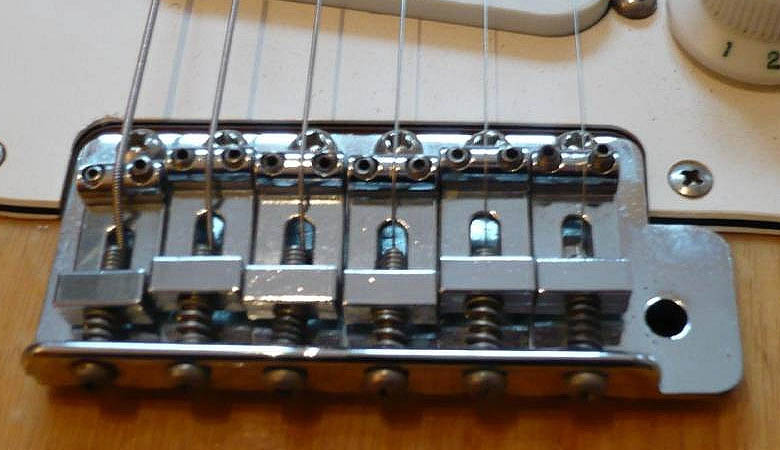 The fretboard of this brandnew 71 Strat stayed untouched. You can hear this stock 71 sunburst Strat (at this time without the tremolo modification) on the "Machine Head" recordings from December 1971, as well as the 70 Strat from December 1971. After retiring the 70's sunburst Strat around summer 1972, Ritchies guitar tech pulled the old, modified two-piece steel tremolo with the custom-made tremolo-arm out of it, and put it into Ritchies new 71 sunburst Strat, because the new Fender one-piece diecast tremolo was not a good option for Ritchies modification. Steel is much harder and less fragile compared to diecast. It was no problem, to tap a larger thread into the steel block of the tremolo, to make the custom-made tremolo-arm fit perfectly. As a second modification, Ritchie replaced the old steel saddles of his steel tremolo with the new ones out of diecast. Naturally, both sunburst guitars looked very similar, you can identify the new 71 Strat because of the "bullett trussrod" on the headstock, the older 70 Strat still had the classic trussrod with the walnut-dot at the headstock. Another difference is the fretboard, the 70 Strat had a much darker one, because of the missing lacquer, showing all the dings and dongs from years of playing. The new 71 Strat sounded a little less punchy, possibly caused through the new three-bolt neck construction, but because of the use of a treblebooster this was more or less negligible. 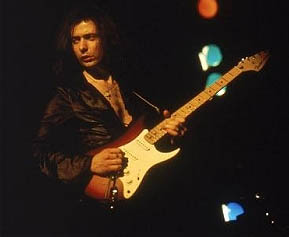 The new 71 Strat had a more airy and pearly attack, something that Ritchie really liked and felt in love with more and more.
The new 71 Strat had a more airy and pearly attack, something that Ritchie really liked and felt in love with more and more.The 68 Strat was only used from time to time until mid 1972, when Ritchie decided to play a show with a really fat and overdriven sound - this was where his 68 Strat really starts to shine ! At the early 1972, Ritchie played this black 68s Strat as often as the 71s sunburst Strat, but he switched back to only the sunburst Strat soon, because at the end of 1972 Ritchie started to prefer a straight tone with a good attack. This preference existed during the whole DP_Mk3 period, and still during his early Rainbow days. The 71 sunburst Strat was used until the end of DP_Mk2 in summer 1973 and Ritchie destroyed this wonderful guitar on stage at one of the last DP_Mk2 concerts in Japan. For the last concert in Osaka on June, 29th, Ritchie used a white 73's stock Fender Strat with maple neck as a substitute. Ritchie Blackmore in the studio, recording the "BURN" album in the early Deep Purple Mk3 period and at one of the last live shows of Deep Purple Mk3. He's playing his heavy weighted early/mid 1973 Fender ash Stratocaster with scalloped fretboard, maple neck and original staggered Fender singlecoil pickups. This guitar had a extra fat neck, which was one of the reasons why it sounded so great. This axe was his first scalloped guitar ever, and his only one with a scalloped maple neck! He loved this guitar very much, and it was his main axe during the complete Deep Purple Mk3 period and the early Rainbow days. 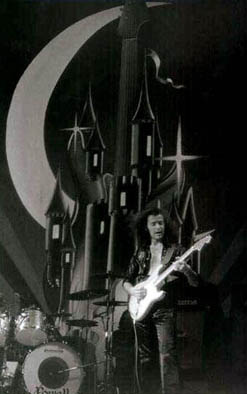 After this guitar was stolen out of Ritchie's house, he only played 70's "big head" Fender Strats with scalloped rosewood fretboard. During the "Burn" Session, Ritchie was very creative with his gear, he used everything he liked. Now he was the leader from Deep Purple (DP_Mk3) and could experiment with whatever he wanted.
After this guitar was stolen out of Ritchie's house, he only played 70's "big head" Fender Strats with scalloped rosewood fretboard. During the "Burn" Session, Ritchie was very creative with his gear, he used everything he liked. Now he was the leader from Deep Purple (DP_Mk3) and could experiment with whatever he wanted.Besides his HS Booster Ritchie used different amps, even a small car-battery powered transistor amp ("Sail Away") out of the tone studios junk room. From spring 1974, Ritchie will use a partly new live setup: the pre-amp of his Major amps are modified now, the treblebooster was retired and replaced with the famous AIWA TP-1011 reel-to-reel recorder, built in December 1970. For his studio work, Ritchie started to use the AIWA machine as a booster lately at the middle/end 70's One of the last pics of Ritchie with his beloved scalloped maple neck ash Stratocaster at the end of the Deep Purpe Mk3 period, here playing with RAINBOW in 1975. Later this guitar was stolen out of Ritchies house and never showed up again. Ritchie really liked the one-piece diecast inertia bar with the diecast saddles, commonly found on all 70's Strats. He never liked the earlier vintage saddles out of metal to much. He also preferred the original staggered Fender singlecoil pickups of the early 70's with the bright and biting sound. In spring 1974 Fender introduced the more cost effective non-staggered (aka "flat pole") pickups, that Ritchie never liked. A perfect substitute for this early 70's Strat pickups are the Fender Custom Shop "'69s" pickups (aka "Abigail Ybarra pickups") and the LeoSounds "VPS Fireball" pickups. With the overwound pickups of today, it's not possible to nail Ritchies pre 1977 tone! A 1976 pic from Ritchie, playing with RAINBOW. He's playing his famous late '73 (or maybe early '74?) white Fender Strat with the scalloped fretboard and the original, staggered Fender singlecoil pickups. In the background you can see the AIWA tape recorder, with the german Schulte "Compact Phasing A" phaser on top. This was a 8-stage phaser that was built in Berlin/Germany, similar to the 6-stage MuTron phaser. 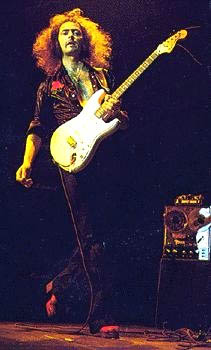 You can hear this unit on "Catch the Rainbow". Another excellent example for using this phaser, is the 1974 "Autobahn" album from the german band "Kraftwerk", the first german band ever who was able to place a record in the US charts - it was exactly this album! The AIWA TP-1011 tape recorder was Ritchie's echo and booster machine from spring 1974 (start of the "Burn" tour) until 1992. At this time, the AIWA partly went bad, and was only used as a booster, while a warm and mild sounding 19" rack-mounted Yamaha digital delay was used for the echo and delay effects.
You can hear this unit on "Catch the Rainbow". Another excellent example for using this phaser, is the 1974 "Autobahn" album from the german band "Kraftwerk", the first german band ever who was able to place a record in the US charts - it was exactly this album! The AIWA TP-1011 tape recorder was Ritchie's echo and booster machine from spring 1974 (start of the "Burn" tour) until 1992. At this time, the AIWA partly went bad, and was only used as a booster, while a warm and mild sounding 19" rack-mounted Yamaha digital delay was used for the echo and delay effects.Ritchie Blackmore in late 1976 or early 1977 with his famous early 1974 Fender Stratocaster with scalloped fretboard and staggered singlecoil pickups. This was one of his favorite axes with a real killer tone. One of the reasons why this guitar sounded so good, was the extra fat neck profile of the maple neck. He also played this guitar on the legendary "Rockpalast" concert on the 20.10.1977, produced and broadcasted from the "Olympiahalle" in Munich/Germany. In the background you can see the AIWA tape recorder, this time without the Schulte Phaser on top. This was the first Stratocaster that Ritchies former guitar tech John "Dawk" Stillwell took care of. At this time, Rainbow used a huge rainbow on stage, equipped with more than 4.000 bulbs and this caused a lot of humming noises in Ritchies stock singlecoil pickups. The amount of hum and noise was so annoying, that Ritchie had problems, to concentrate on his difficult solo parts, so he wanted to get rid of this problem. First John Stillwell tried to shield the pickup routings of the Stratocaster with different materials to solve this problem, but the success was minimal. So he decided to modify the stock Fender staggered singlecoil pickups, by overwounding them. He decided to only overwound them slightly. John Stillwell put an additional 1000 ohms on the Fender pickups, and afterwards Ritchie used this guitar until early 1978 as his main axe. His retired 1974 sunburst Strat was used now from time to time for some "old sound" songs. In 1980 Ritchie beheaded this axe in a wild fit of rage. 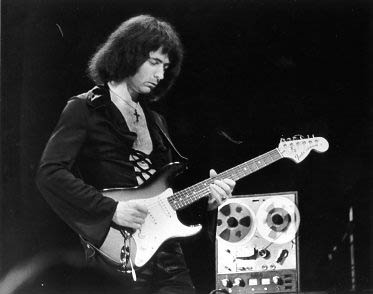 In early 1978 Ritchie started to use his first hum cancelling Stratocaster, designed and built by his tech "Dawk" Stillwell. Ritchie also wanted a more modern sound, and finally he choose the "Velvet Hammer" pickups from Red Rhodes, high quality overwound Fender style pickups with staggered polepieces and a DC resistance of approx. 9kOhm.
In early 1978 Ritchie started to use his first hum cancelling Stratocaster, designed and built by his tech "Dawk" Stillwell. Ritchie also wanted a more modern sound, and finally he choose the "Velvet Hammer" pickups from Red Rhodes, high quality overwound Fender style pickups with staggered polepieces and a DC resistance of approx. 9kOhm.The slightly increased output of this pickups were not the main reason for Ritchie's choice, because the preamp stage of his AIWA still had plenty of gain. In the middle position of the pickguard, Dawk installed a dummy coil construction, so together with the bridge or neck pickup, Ritchie received a humbucking effect. The dummy coil was a demagnetisized pickup. Furthermore, this black pickguarded Strat that Ritchie used for more than two years, was equipped with Dawk's Master-Tone-Control (MTC), with which Ritchie was able to get a creamier lead tone, if he wanted to. This Strat was used from 1978, during the last months with Ronnie James Dio as lead singer, over the complete time with Graham Bonnet up to the early days with Joe Lynn Turner on vocals. In late 1979 a new guitar showd up more and more on stage in parallel to the black pickguarded one, replacing it completely in 1980 and becoming Ritchie's trademark axe. At the end of 1979 Dawk showed a new pickup to Ritchie, the uncommon Schecter F500T, and Ritchie loved it right from the start. For a Strat style pickup, the Schecter had very fat 1/4" (approx. 6.3 mm) polepieces and a tapped coil to switch between a classical fenderish singlecoil tone with slightly increased output to high output. 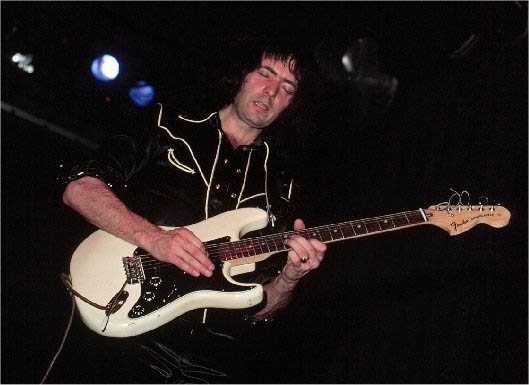 Because of the fat magnets, the tone was very meaty with a punchy bass, something that Ritchie really liked at this time, because he wanted to get rid of this typical thin bass response of a Stratocaster, but keeping the typical singlecoil tone that Ritchie loved so much. Dawk did not wired the Schecter pickups for full output, he wired them for a tapped, low output but with his own genious behind it. The gain still came from Ritchie's AIWA tape recorder.
Because of the fat magnets, the tone was very meaty with a punchy bass, something that Ritchie really liked at this time, because he wanted to get rid of this typical thin bass response of a Stratocaster, but keeping the typical singlecoil tone that Ritchie loved so much. Dawk did not wired the Schecter pickups for full output, he wired them for a tapped, low output but with his own genious behind it. The gain still came from Ritchie's AIWA tape recorder.Dawk only connected the inner half of the lead pickup's coil and the outer half of the neck pickup's coil to receive additional bass response - a very tricky but effective wiring! In the center position Dawk still used a dummy coil and his MTC wiring (see above). The colors of this Stratocaster now became Ritchie's trademark: a white "big headed" Stratocaster, scalloped maple neck with rosewood fingerboard, white pickguard with black pickup covers and also black knobs, switch and tremolo-arm tips. This guitar showed up on stage in late 1979 and was used side by side with the black pickguarded "Velvet Hammer" Strat in early 1980 and replaced this one completely on stage during 1980, becoming Ritchies favorite axe. Some more words about humbucking with a dummy coil in general: the nearer the two phase-inverted coils, the more effective the humbucking effect, eg. in the classical PAF pickup, or in the humbuckers in a singlecoil casing. In Ritchie's Strat, the both coils are positioned far away from each other, so the humbucking effect was good, but not as good as in a typical humbucker pickup. The amount of hum was very little, but still there, so Ritchie's chase for the perfect hum-free Stratocaster still continued ...... 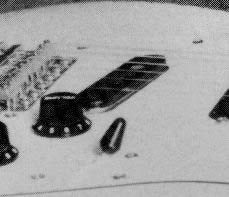 Ritchie still had his problems with the F500T Stratocaster, because a pickup installed at the neck position, is always a tad louder than a pickup in the bridge position. Ritchie really loved the round and full tone of his neck pickup, but the bridge pickup was to thin and punchless for the fat lead-sound he wanted.
Ritchie still had his problems with the F500T Stratocaster, because a pickup installed at the neck position, is always a tad louder than a pickup in the bridge position. Ritchie really loved the round and full tone of his neck pickup, but the bridge pickup was to thin and punchless for the fat lead-sound he wanted. To solve this problem, the F500T pickup was soldered for full gain after a short time. To prevent the pickup from getting louder as intented, it was lowered to increase its distance from the strings (see pic). Ritchie was very happy with the sound of this Strat now, but this procedure also created an unwanted side-effect. For a perfect humbucking, both coils have to be as near as possible plus they should have the same number of windings! The dummy-coil was developed and balanced for the neck pickup (and of course for the bridge pickup before this procedure), but for the bridge pickup with full gain it was to weak now ... it was simply underwound. Furthermore, when combining a pickup with a dummy-coil, the inductance of both is added on each other, which means a noticeable treble loss. The neck pickup together with the dummy-coil sounded awesome and was almost hum-free, but using a fatter dummy-coil together with the bridge pickup was over the top, the sound was very dull, loosing all the top-end and bite, and Ritchie was unhappy again. To get rid of the treble loss, the original dummy-coil for the neck pickup was used for the bridge pickup again. The top-end came back, but now the bridge pickup produced noticeably more hum than the neck pickup. Ritchie could live with that, but he was not very happy about it. For a short time, Ritchie used a modified modern 5-way pickup selector switch, to toggle between the bridge pickup's full and half winding, but this didn't last long, because Ritchie was used to simply flip the switch between the two outer positions, so he don't wanted to mess around with the in-between positions of a 5-way switch. 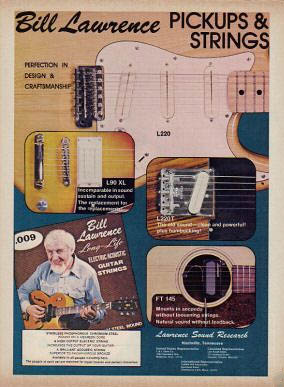 From now on, Dawk and Ritchie tested a lot of new pickups, especially the new singlecoil-sized humbuckers. The first well working pickup of this new breed was the Bill Lawrence L-250 with approx. 12kOhm DC resistance.
From now on, Dawk and Ritchie tested a lot of new pickups, especially the new singlecoil-sized humbuckers. The first well working pickup of this new breed was the Bill Lawrence L-250 with approx. 12kOhm DC resistance.Bill Lawrence was a tech-wiz, constructing the Gibson "Super Humbucker" (PAF style pickup with three ceramic magnets) in the 70's and the genious Gibson L-6S Custom "Multi Sound System". These L-250's are single coil sized humbuckers, with a single blade instead of polepieces. The coils are wound vertically and placed on either side of the blade, not on top of each other. This was Ritchie's first hum-free singlecoil-sized pickup, but Ritchie was not very pleased with the sound of the L-250, especially the neck pickup sounded very different compared to a real singlecoil. First and foremost this was because of the blade's even magnetfield underneath the strings, compared to the common six individual magnets and the resulting uneven magnetfield underneath the strings, mostly in charge of the typical singlecoil sound. In spite of this problem, Dawk built a white Strat for Ritchie, equipped with a white pickguard and white pickup covers for the L-250 pickups, painted black after a short time to match Ritchie's new guitar line-up. The slightly humming F500T Strat still remained Ritchie's favorite axe. Some time later, the Lawrence L-450 pickup was released (12kOhm DC resistance, wired in series), a twin-blade humbucker with the side by side coils in standard singlecoil size. This pickup was used for another Strat with Ritchie's trademark colors and replaced the L-250 Strat in 1986. The L-450 had one important advantage compared to the L-250: full access to all coil-windings on the bottom-plate ! So it was possible to combine both coils in series for a high-output, mid-rangy sound or in parallel for a clear tone with standard output. Dawk wired the neck pickup in parallel, and the pickup sounded much better now, compared to the mid-rangy sounding L-250, wired in series without the possibility to change it. Ritchie don't wanted a lot of power from his neck pickup, he wanted pure tone without any compromises. The bridge pickup was also wired in parallel, but in a nutshell, the neck position is always a tad louder than the bridge position, and Ritchie wanted more punch from the neck pickup - the same old story as with the F500T pickups. So the bridge pickup was wired in series and again the pickup was lowered to increase its distance from the strings, to prevent the pickup from getting to loud. Some time later, the L-450 at the bridge position was replaced with the more modern XL-450. This twin-blade L-450 guitar along with the F500T axe will be Ritchie's main axes for a long time. 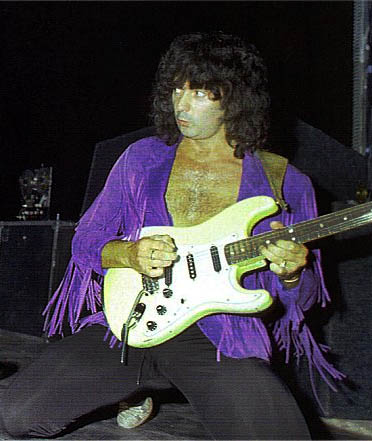 Ritchie didn't liked the L-450 to much, because it did not sound exactly like a classical singlecoil, but it was absolutely hum-free. From now on, Dawk will custom built more then two dozends Stratocasters for Ritchie, all with different pickup combinations, and also some with the new stacked-coil pickups like the DiMarzio HS-2, but they all did not match Ritchie's taste. Besides of his "Master Guitars", Ritchie smashed most of them on stage.
Ritchie didn't liked the L-450 to much, because it did not sound exactly like a classical singlecoil, but it was absolutely hum-free. From now on, Dawk will custom built more then two dozends Stratocasters for Ritchie, all with different pickup combinations, and also some with the new stacked-coil pickups like the DiMarzio HS-2, but they all did not match Ritchie's taste. Besides of his "Master Guitars", Ritchie smashed most of them on stage. But some more words about the Lawrence pickups, Ritchie's favorite choice. For some time, Ritchie used a mixed Frankenstein-Stratocaster, with a Schecter F500T at the bridge position and a normal "Black Label" Bill Lawrence singlecoil with six individual magnets at the neck position. Naturally a dummy-coil was used in the center position. The numerous pickguards with the different electronics moved from guitar to guitar, eg. the original Strat with the F500T electronic received a L-450 pickguard when Ritchie stopped using the F500T pickups. This Stratocaster was his Master-Strat, independent from the electronic. And the search for the perfect pickup continued ..... We only want to shed some light on the important pickups Ritchie used, the short living models and the less important ones will remain unmentioned, because they never played any role for Ritchie. Same with the Roland GK-2 Synthesizer system, but it should be mentioned, that Ritchie played a minimum of at least two Strats, equipped with this system. The pickup configuration of this guitars will change over the years. The final most important pickup for Ritchie was the new patented pickup model (US-Pat.# 4.809.578) from Don Lace who named it "Lace Sensor". This pickup also showed up on regular Fender guitars. This pickup was a completely new constructed singlecoil, invented by Donald Lace in his "Actodyn" company, designed for minimum hum and noise. The pickup was available in several versions, categorized by its output and sound - Ritchie played the "Gold" version, which was very similar in sound and output like the old Fender standard singlecoil Strat pickups. With this pickups, Ritchie's chase for the perfect pickup finally ended. From now on, he used his F500T Strat only from time to time, same with the L-450 Strat. After some internal troubles, Ritchie left Deep Purple again in November 1993, making music with his own band now, again under the "Rainbow" name. In this band, with a completely new crew compared to the original Rainbow band, Ritchie played first and foremost Stratocasters with Lace Sensors, some of them with an additional Roland GK-2 Synthesizer system. The Lace Sensor pickups had a white casing, but Ritchie painted them black, at this time it was obvious to see, that the black paint was partially scraped off from hitting the pickups with the plec, so later he only used the original white pickups without painting them black and he also throw away all the rest of the black plastic parts on his pickguards, using completely white pickguards again. This became his new Stratocaster signature look for a long time. The only surviving guitar from former times was his L-450 equipped Strat. He also still used his old and trusty AIWA, but because of mechanical problems in 1992 only as a booster, since 1992 the typical Blackmore 2/3 sec. echo came from a big Yamaha digital delay. He used this 19" rack-mounted Yamaha delay for his last Deep Purple studio recordings ("The Battle rages on ..." from early 1993) as well as for the last live recording "Come hell or high water" from late 1993 and on all his later solo recordings. Even in 2008 Ritchie used the AIWA as a booster for his live performances with "Blackmore's Night", but in the meantime the AIWA was placed backstage, because without the tapes it looked really nasty. Ritchie also retired his monster amps, the Marshall Major 200. In general Ritchie was still pleased with its tone, but for Ritchie's new trademark sound, this amps are incredible loud. At lower volumes, this amps could not produce the typical Blackmore sound of this decade. 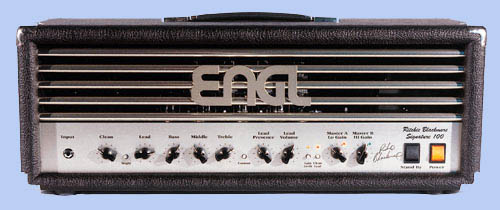 Now that Ritchie crossed his 40's, he wanted to get things more gently with Rainbow, and this was exactly something, that the Major amps could not do for him, without loosing the character of the tone. Ritchie decided to use an ENGL Savage 120 amp on the Rainbow stage, for smaller stages he used a 2x12" 50watt ENGL Sovereign combo amp, that he also sometimes used additionally on the Rainbow stage.
Now that Ritchie crossed his 40's, he wanted to get things more gently with Rainbow, and this was exactly something, that the Major amps could not do for him, without loosing the character of the tone. Ritchie decided to use an ENGL Savage 120 amp on the Rainbow stage, for smaller stages he used a 2x12" 50watt ENGL Sovereign combo amp, that he also sometimes used additionally on the Rainbow stage.Later with "Blackmore's Night" he played the same combo, but with a 1x12" configuration. Some time later, ENGL will release his own Blackmore signature amp, based on the Savage, but tuned to Ritchie's ideas and with 150watt. Now Ritchie crossed the final landmark for his own signature sound. Ritchies studio setup from the late 70's From the late 70's on, Ritchies favorite studio setup includes a modified Marshall Major amp and his old AIWA reel-to-reel tape recorder as a preamp. To record his amps and cabs, he usually used three mics: a Shure SM57 (approx. 10 cm in front of the cab), a Shure SM56 (approx. 1,5 meters away from the cab) and a Neumann U87 (approx. 50 cm in front of the cab). Ritchie Blackmore's Mk2 sound 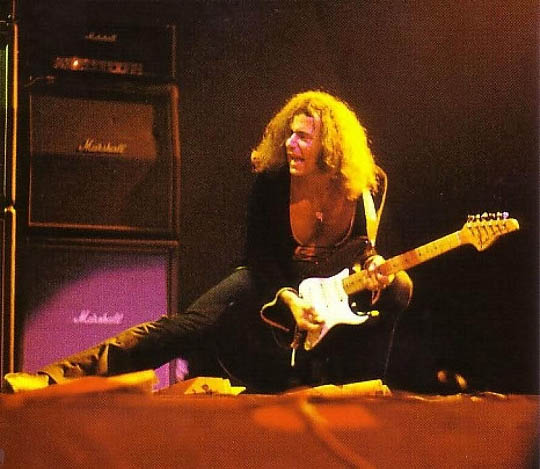 The DP_Mk2 sound of Ritchie Blackmore is dominated by the combination of a treblebooster and a 200 watt Marshall Major amp. The circuit of the Major amps is very unique and has nothing to do with the common 50 and 100 watt models. So the 200 watt Marshall Major is not a louder 100 watt Marshall amp, the Major has a very special tone. During the years, several versions of the Major amp had been released, the first edition from 1967 named "Marshall 200" and nicknamed "the pig" (two inputs, three controls for bass, treble and volume) is not important for us here. 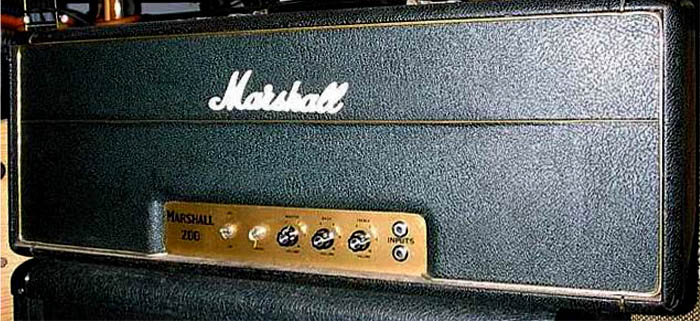 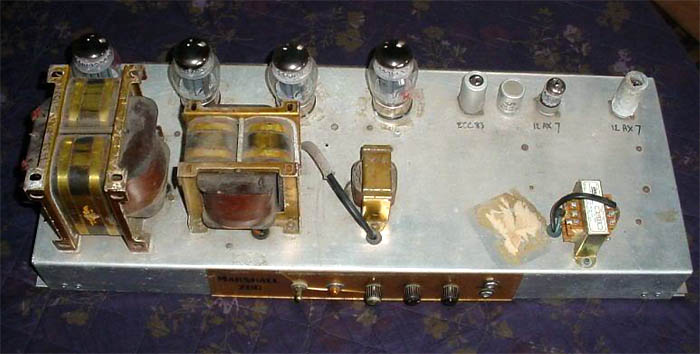 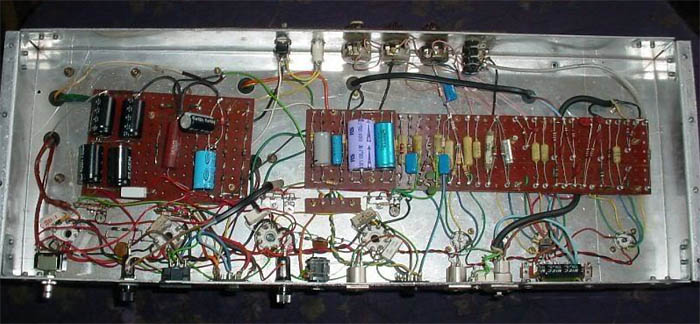 Only the later versions from 1968-1974 with the typical Marshall cosmetics, four inputs and six controls named "Marshall Major" are important for us, because Blackmore played only this amps. Sporting an ultra-linear power stage, KT88 beam-power tetrodes and a Class-A push/pull driver stage, the Major is close to the typical hi-fi concepts, this is the reason for the tight and focused bass response of this amp. Because of the ultra-linear power stage (aka "screen-grid negative feedback"), the internal resistance of the power stage is lowered notably, or as the hi-fi guys like to call it: the damping factor is raised notably. Because of this, the speaker is driven more precise, especially in the bass frequencies, works more stable and with less tolerances from its nominal parameters, eg. a lower THD factor and a better frequency response. That's exactly the reason, why the ultra-linear concept is so widely used for high-priced hi-fi units. 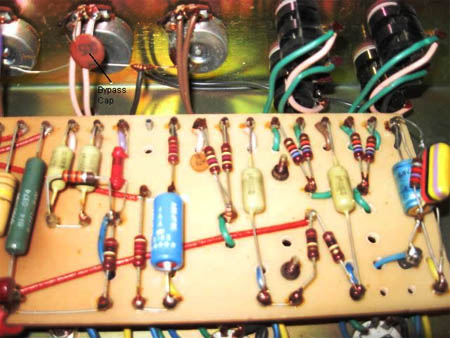 During the years, two slightly different versions of the Major lead series (there are also Major models for bass and PA purposes) had been released, the difference was only about one single component, a treble bypass capacitor, soldered between in- and output of the volume pot.
During the years, two slightly different versions of the Major lead series (there are also Major models for bass and PA purposes) had been released, the difference was only about one single component, a treble bypass capacitor, soldered between in- and output of the volume pot.In comparison to the 50 and 100 watt Marshall models of this time, this capacitor was small, similar to the ones used on the "Bright Switch" on many Fender amps. Later on, the Major received the same bypass cap like the 100 watt Marshall amps. The reason for this bypass cap was to keep the treble alive, when rolling back the volume. Because of this and depending on the volume, the upper highs were boosted notably. Other than on the Fender, Boogie, Dumble and some other amps, you could not switch off this boost. The Major amps with the treble bypass cap are called "Bright Volume" (BV), this amps did not show up until early/mid 1972 - the amps without the cap are called "Neutral Volume" (NV). After early/mid 1972, only the BV amps were produced. At the end of 1972, Ritchie switched over to this new BV version, its shining, bright tone is easy to identify. 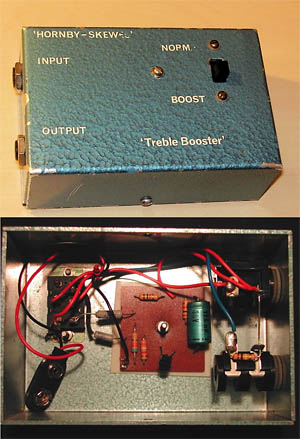 The Hornby-Skewes treblebooster existed is several versions with at least four different capacitor arrangements and two different transistor setups. Only two of this versions have been used by Blackmore.
The Hornby-Skewes treblebooster existed is several versions with at least four different capacitor arrangements and two different transistor setups. Only two of this versions have been used by Blackmore.Until spring 1971, Ritchie used the germanium version of the Hornby-Skewes (HS) version, as well as one of the silicon versions. Ritchie owned three HS booster in 1971, one of them was modified around 1970 and received an additional volume control. The silicon version was also used in the studio, eg. on the late 71 "Machine Head" recordings. For this recordings, he mainly used a VOX AC30 and his old red ES-335 was used for at least one song. Ritchie hired the tech Bill Hough from one of the first super-groups of the 70's, Emerson, Lake & Palmer. This electronic wizard was in charge of the service for the ELP keyboards from Keith Emersons, and built a booster for Ritchie that did not suffer from picking up radio signals and the mid-rangy and compressed sound of the Hornby Skewes booster. Bill Hough built his electronics into the enclosure of the modified HS booster model with the additional volume control, by simply taking out all of the original guts. Hough's custom made silicon booster (CM) was used from spring/summer 1971 until the end of the DP_Mk2 period in summer 1973, but with one exception: the legendary "Made in Japan" recording from fall 1972 was recorded with the old HS germanium booster. Ritchie used the following amp settings around 1972 with his Marshall amp: Presence: 0 / Bass: 4 / Middle: 5 / Treble: 6-7 / Volume:6-7 On a lot of live recordings Ritchie used the CM booster, eg. the legendary "Beat Club" session from autumn 1971, the marvelous BBC session (aka "In Concert 1970-72") from spring 1972 - both sporting the fresh and airy guitar sound - but the New York (NY) show from Hofstra University from 1973 as well, this time recorded with a new Major BV version amp. Especially on this recording, it's easy to hear the additional glassy-brilliant amount of treble as well as the funky, punching bass of the BV Major version. Ritchie Blackmore's Mk3 sound 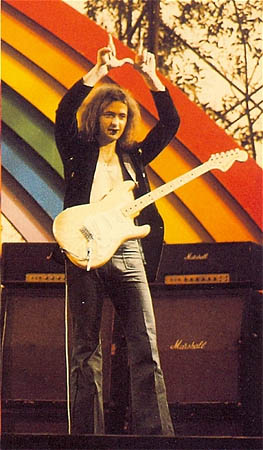 Ritchies sound during his DP_Mk3 times, is an interesting subject on its own. Until 1973, Ritchie used the treblebooster in front of his Marshall Major amp during his DP_Mk2 period. With David Coverdale and Glenn Hughes as a substitute for Ian Gillan and Roger Glover in late 1973, Ritchie was the one and only leader of DP_Mk3.
Ritchies sound during his DP_Mk3 times, is an interesting subject on its own. Until 1973, Ritchie used the treblebooster in front of his Marshall Major amp during his DP_Mk2 period. With David Coverdale and Glenn Hughes as a substitute for Ian Gillan and Roger Glover in late 1973, Ritchie was the one and only leader of DP_Mk3.He wanted to use an echoe effect for his live performances, but sadly he did not found anything to taylor his needs and after trying numerous echoe devices, he ended up with his home-based AIWA TP-1011 tape recorder - he did not like the well-known and common tape-echoe machines of this time like the Echoplex or the WEM Copycat. In a nutshell, this specific AIWA machine was nothing fancy, just a simple budget 3-head tape recorder and not even in the same ballpark, compared to the top of the line models of this time from japanese manufacturers like Sony, AKAI, TEAC and Dokorder, the US-made Ampex or the famous swiss-made REVOX machines - Ritchie tried almost all of them! The main AIWA products at this time were handheld dictaphones and small budget tape recorders. Besides this, AIWA also offered some "real" 7-inch open-reel machines, to compete with the other companies. Some of this machines were battery-powered, some others offered a built-in amplifier and small speakers - all typical things at the late 60's. The TP-1011 (with a tape speed of 19cm/sec.) was the only useable machine from AIWA at this time for hi-fi purposes. But the inexpensive AIWA machine contained a need feature, that not all three-head machines had: the socalled "Sound-on-Sound" switch (aka "SOS switch"), providing an echoe effect by pushing a button. Adjusting the "Repeat" time was always a challenge, beacause the only way to do that, was to use the tape-speed: 19cm/sec. - 9.5cm/sec. - 4,75cm/sec. which was a 1/3 sec. or a 2/3 sec. delay that raised Ritchie's attention. At DP Mk3 Ritchie used the 1/3 sec. delay exclusively, later on with "Rainbow" he used the 2/3 sec. delay as well. To bust some myths and urban-legends ..... the AIWA TP-1011 was not tube-powered and it also did not contain any germanium transistors - the whole machine was pure silicone powered! But by accident, the AIWA's mic pre-amp stage worked perfectly together with Fender-style pickups. Because a guitar pickup is not a microphone, that's not always the case and depends on the specific tape machine. There are many tape machines (independent from the manufacturer, price and model) which did not work together with a guitar pickup, connected to the mic pre-amp input, so it was pure luck that it worked with the AIWA and Ritchie really liked this sound. As a downside, the AIWA did not work with Ritchie's Hornby-Skewes treblebooster in front of the machine, the result was a very distorted and noisy tone. 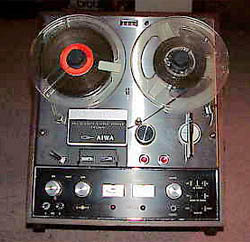 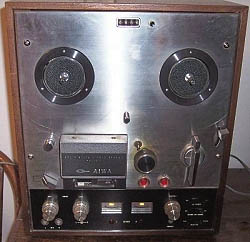 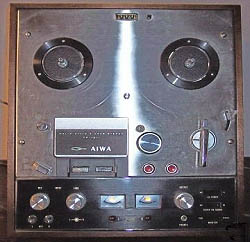 So Ritchie went to the Marshall company, because he knew Jim Marshall well from his successless early days in the music scene in the mid 60's, when he spent a lot of time, hanging around in Jim Marshall's music shop. To quote Jim Marshall: "Ritchie more or less lived in my shop" As a result, Ritchies Major 200 Lead amp was modified by cascading the pre-amp stage, connecting an additional pre-amp stage with relatively low gain (approx. factor 10 = 20dB instead of the common 35dB of a common used pre-amp tube) together with the stock one. 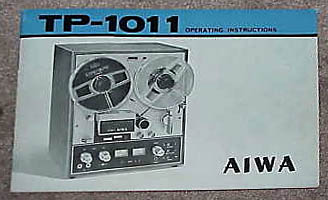 The reason for this was, that the AIWA had something more to offer besides only an echoe-effect: gain until the very end and a high output level ! This was the reason, why Ritchie's amp was not modded for maximum gain. The necessary high-pass function was built into the new cascaded pre-amp stage of the amp, because the Hornby-Skewes treblebooster which fullfilled this function in the past was not longer used.
The reason for this was, that the AIWA had something more to offer besides only an echoe-effect: gain until the very end and a high output level ! This was the reason, why Ritchie's amp was not modded for maximum gain. The necessary high-pass function was built into the new cascaded pre-amp stage of the amp, because the Hornby-Skewes treblebooster which fullfilled this function in the past was not longer used.The tone stack of the amp was stilled untouched (slope-R of 33kOhm / treble C of 500pF). While auditioning the modified amp in the Marshall factory (maybe not at maximum gain ?!?) Ritchie really liked this new powerful and dirty sound. He used this amp for the US "Burn" tour in spring 1974. There are two recordings, where you can hear this sound: "California Jam" and "Perks and Tit" (aka "San Diego 1974"). But the modified amp also had a downside: the DP_Mk3 stage level was incredibly high and the new, highly motivated bassplayer Glenn Hughes was new a member of the "greatest rockband of the world" ... and he knew that! So he started to use Hiwatt 400 amps with 6 x KT88 power tubes and big bass-bins (built for PA purposes) to hold-up with Ritchies high volume level. So Ritchie had the problem, that he had enough power and volume, but he needed more bite to cut through the mix. With maximum gain, his sound was way to mild, not as agressive and powerful as in the past with the treblebooster in front of the amp. This problem only occured at maximum gain, not below, because of uncompensated saturation-effects of the amp's power stage, caused by the additional gain. Soon after the US tour he went to the Marshall factory again to get rid of this problem, because the England tour was soon to come, starting in Scotland. Besides some other things, the tone stack was modified now with a 56kOhm slope-R and a stock 500pF treble-C, which was raised to 700pF later when Ritchie played with "Rainbow". This mod is very important for Ritchies Rainbow and DP_Reunion sounds! To bust some myths again: Ritchies Lead Major amp still had 4 KT88 power tubes!!! This UK tour is documented as "DP Live in London" from May 1974, recorded by BBC. Ritchies new sound was tight, razor-sharp and with a lot of bite. At the same time he stopped playing the ultra-fat chords from the US tour you can hear on the "Perks and Tit" record in the "Burn" song and he started to play unisone single notes - this was one of the results of his new sound! Ritchie played this amp without any new mods for the rest of his DP_Mk3 period. You can hear this sound on "Made in Europe" and the later "Mk III Final Concerts" and "Live in Paris 1975", all of them recordings from the last three DP Mk3 concerts, short before Blackmore left Deep Purple. In closing, some words about Ritchies 73'ash-bodied Strat he played during his DP_Mk3 times. If you want to nail this specific Ritchie sound, it's important to use a close copy of this axe. Especially the one-piece diecast tremolo with the diecast saddles (a typical, stock feature of the Fender 70's Strats) is important for the tone, it's more or less impossible to get this tone with the vintage steel tremolo and the steel saddles. It's difficult to get such a diecast tremolo today, but a good compromise are the diecast saddles from the Fender "Squier" series - this are easy to find and you can interchange them 1:1 with the vintage steel saddles. The MIM "Fender Classic 70s Strat" with ash body and maple neck (model 013 7002, color #21, natural), is the best bang for the buck and a very good starting point for further modifications. Even the stock pickups of this guitar are perfect for all Blackmore things. The only gripe is the typical Fender tremolo with vintage saddles and screwed inertia bar, but as stated earlier .... this is easy to modify. © Written and researched by Bernd C. Meiser, CEO and mastermind of the BSM company and a longtime confessing Blackmore fan. Besides running the BSM company and building top-notch treblebooster replicas, he's also a writer for the german "Gitarre & Bass" magazine. If you want to contact him, please send him an e-mail. |